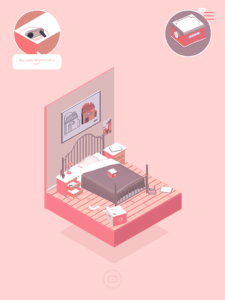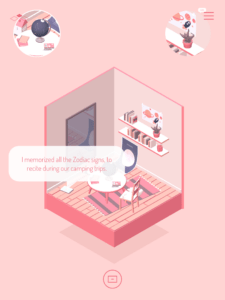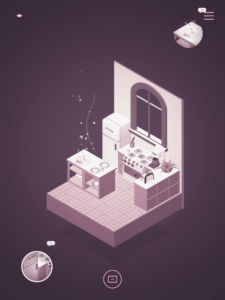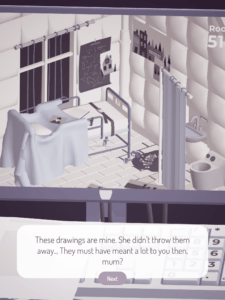I chose The Almost Gone for this assignment, a video game released in 2020 that was developed by Happy Volcano and published by Playdigious. This game explores heavy themes such as mental health, violence, and suicide, making it more appropriate for mature audiences. I had a wonderful time playing “The Almost Gone” on my iPad, but it has also gained popularity on various platforms including Microsoft Windows, Android, and Nintendo Switch.
“The Almost Gone” creates a deeply engaging puzzle-solving experience with only a handful of interconnected spaces at each level. Indeed, each chapter features 5-10 three-dimensional, interconnected rooms, carefully chosen to avoid cognitive overload while maintaining a sense of complexity and discovery. In each of these spaces, players encounter objects that gradually reveal details about Emily’s (the main character) circumstances. Despite the modest number of rooms per level, each is densely populated with significant objects, which creates an illusion of a much larger space (Figure 1). This design choice ensures a rich exploration experience without causing cognitive overload or disorientation. A particularly clever design feature in the game is the ability for players to remain in the same room but travel back in time, revealing historical contexts, such as her parents’ childhoods, that are crucial for solving the mystery (Figure 2). Moreover, the game encourages a continuous sense of discovery in players as objects found in one room often hold the key to puzzles in another, which further enriches the interconnectedness of the different rooms in each level. Therefore, the game’s designers successfully make the user feel immersed in a complex and intricate word through the clever use of time travel and significant objects that are related to one another, while using a limited number of spaces to avoid cognitive overload.
The designers of the Almost Gone chose meaningful correlations between the significant objects in the game, thus creating a balanced puzzle experience that is fun and adequately challenging. IThe Almost Gone is a game that obeys the thirteen rules for puzzles that we have talked about in class, and particularly the rule that clues and puzzles should be clearly linked (rule 5) and that correlations should make sense (rule 6). The game’s puzzle design encourages players to solve each puzzle by finding objects that fall under a consistent theme. For example, numerous puzzles involve opening boxes or doors to reveal further secrets; therefore, when players discover a missing handle, they can readily associate this object with its use, allowing for smooth progression in the game (Figures 3,4). Additionally, puzzle-solving often entails mimicking shapes found in various rooms, or noticing scattered numbers in order to open a safe , or access a computer, etc. (Figure 5).This thematic consistency not only makes the puzzles engaging but also keeps them from becoming overly challenging, which ultimately creates a balanced puzzle experience for the player. The design also strategically differentiates between collectible objects and objects that remain in their original environment. This distinction helps players identify which objects they can use to unravel the game’s mysteries, which further enhances the overall puzzle-solving experience by providing clear and logical paths to follow.
In conclusion, The Almost Gone masterfully utilizes its game mechanics to craft an engaging and immersive player experience, while maintaining a careful balance in its puzzle complexity. The designers successfully create an illusion of a large and rich world through the strategic use of interconnected, three-dimensional rooms, each populated with various significant objects. This setup prevents cognitive overload by limiting the number of rooms, yet enriches the narrative depth and complexity perceived by the player. Furthermore, the puzzles are consistently themed, ensuring that each element feels integrated and meaningful within the game’s context. This thematic coherence not only aids in maintaining a clear narrative thread but also enhances the player’s ability to solve puzzles without feeling overwhelmed. By focusing on these consistent themes and manageable spaces, the designers successfully deliver a balanced and compelling gameplay experience that feels both expansive and intricately detailed, without sacrificing player engagement or narrative impact.








